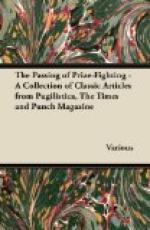* * * * *
THE MOO-COW.
I was getting so tired of the syncopated life of town (and it didn’t fit in with my present literary work) that I bribed my old pal Hobson to exchange residences with me for six months, with option; so now he has my flat in town, complete with Underground Railway and street noises (to say nothing of jazz music wherever he goes), and I have his country cottage, old-fashioned and clean, and a perfectly heavenly silence to listen to. Still, there are noises, and their comparative infrequency makes them the more noticeable. There is, for instance, a cow that bothers me more than a little. It has chosen, or there has been chosen, for its day nursery a field adjoining my (really Hobson’s) garden. It has selected a spot by the hedge, almost under the study window, as a fit and proper place for its daily round of mooing.
Possibly this was at Hobson’s request. Perhaps he likes the sound of mooing, or, conceivably, the cow doesn’t like Hobson, and moos to annoy him. But surely it cannot mistake me for him. We are not at all alike. He is short and dark; I am tall and fair. This has given rise to a question in my mind: Can cows distinguish between human beings?
Anyway the cow worries me with its continual fog-horn, and I thought I would write to the owner (a small local dairy-farmer) to see if he could manage to find another field in which to batten this cow, where it could moo till it broke its silly tonsils for all I should care; so I indited this to him:—
MY DEAR SIR,—You have in your entourage a cow that is causing me some annoyance. It is one of those red-and-white cows (an Angora or Pomeranian perhaps; I don’t know the names of the different breeds, being a town mouse), and it has horns of which one is worn at an angle of fifteen or twenty degrees higher than the other. This may help you to identify it. It possesses, moreover, a moo which is a blend between a ship’s siren and a taxicab’s honk syringe. If you haven’t heard either of these instruments you may take my word for them. Further, I think it may really assist you if I describe its tail. The last two feet of it have become unravelled, and the upper part is red, with a white patch where the tail is fastened on to the body.
It is only the moo part of the cow that is annoying me; I like the rest of it. I am engaged in writing a book on the Dynamic Force of Modern Art, and a solo on the Moo does not blend well with such labour as mine.
There are hens here at Hillcroft. This remark may seem irrelevant, but not if you read on. Every time one of these hens brings five-pence-halfpenny worth of egg into the world it makes a noise commensurate with this feat. But I contend that even if your cow laid an egg every time it moos (which it doesn’t, so far as my survey reveals) its idiotic bellowing would still be out of all proportion to the achievement. Even milk at a shilling a quart scarcely justifies such assertiveness.




